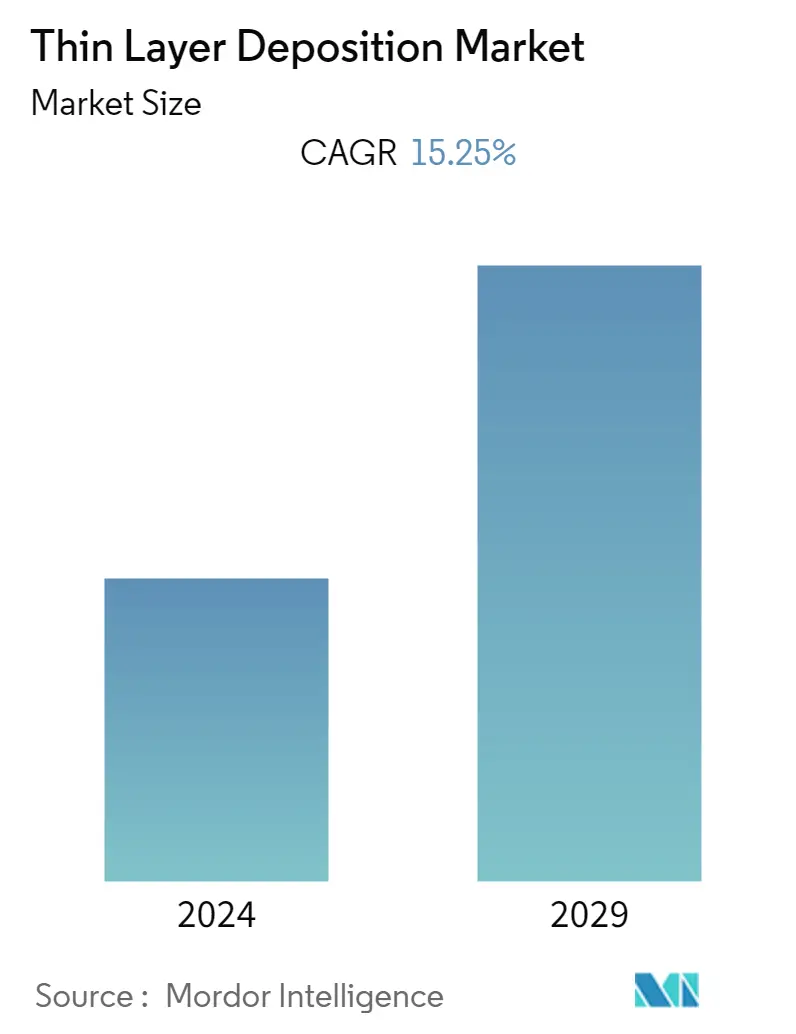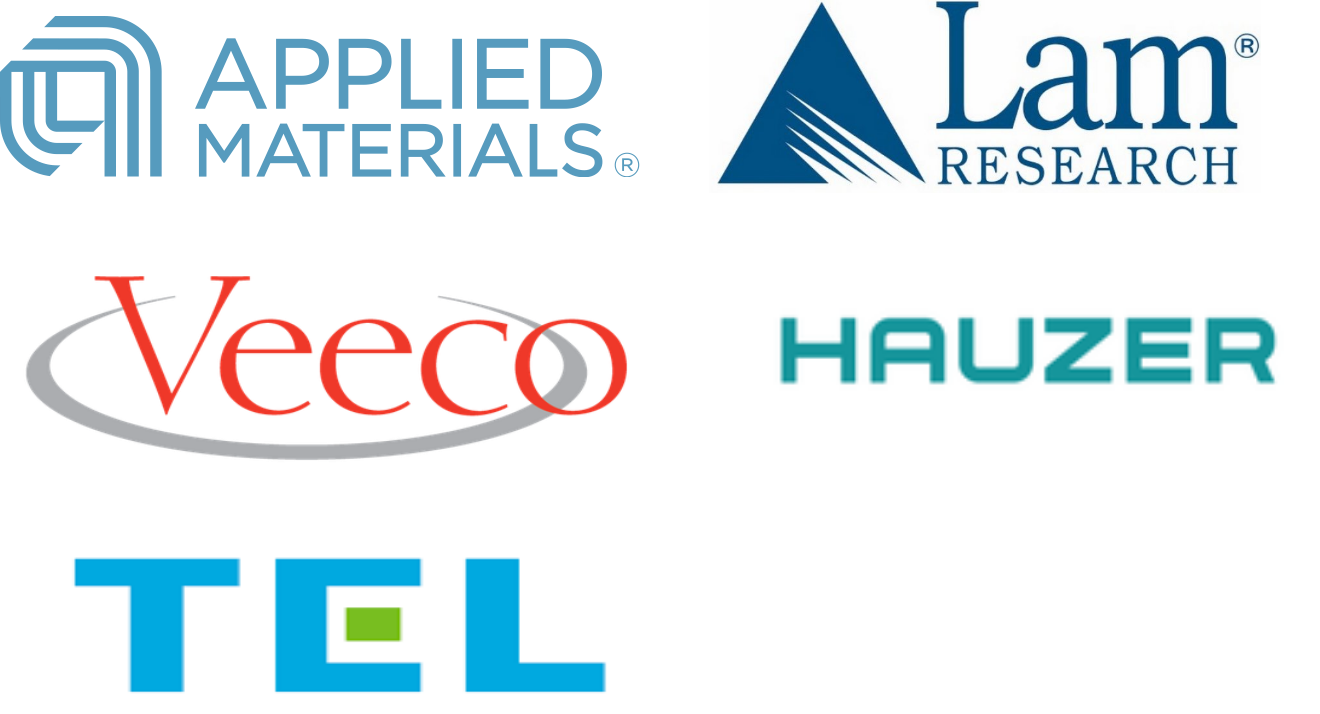| Study Period | 2019 - 2029 |
| Base Year For Estimation | 2023 |
| Forecast Data Period | 2024 - 2029 |
| CAGR | 15.25 % |
| Fastest Growing Market | Asia Pacific |
| Largest Market | Asia Pacific |
| Market Concentration | High |
Major Players*Disclaimer: Major Players sorted in no particular order |
Thin Layer Deposition Market Analysis
The thin layer deposition market is expected to register a CAGR of 15.25% over the forecast period of (2021 - 2026). In April 2019, The Centre for Process Innovation (CPI) and Beneq have signed a long term collaboration agreement for the use of atomic layer deposition (ALD) technologies in printable electronics applications.
- Thin-film semiconductor deposition is a next-generation technology which is achieving rapid acceptance across various industries. Range of applications of thin-film semiconductor in solar panels will create an increasing demand in thin-film semiconductor deposition manufacturing.
- The demand for thin layer deposition semiconductors has increased due to their advantages such as lightweight, higher efficiency, less space consumption, and flexibility in shape. They are widely used in various applications such as solar panels, DRAMs, microprocessors, and wearable technologies among others.
- The market is largely driven by the increasing demand for microelectronics and flexible electronics such as flexible display & batteries. Moreover, the need for miniaturization of the circuit had supplemented the growth of Thin-layer deposition market. The requirement for advanced OLED displays will further boost the demand in the coming years.
- Moreover, the surge in demand of sensors in the smartphone industry and increasing application of solar systems in household equipment, transportation facilities, and aircrafts are expected to create numerous opportunities for the growth of thin-layer deposition market in the coming years.
- However, restraints associated with the thin layer deposition market is huge initial investment required for setting up a new manufacturing facility for thin layer deposition and increasing the cost of raw materials.
Thin Layer Deposition Industry Segmentation
Thin Film Deposition is the method of applying a very thin film of material between a few nanometers to about 100 micrometers, or the thickness of a few atoms onto a substrate surface to be coated, or onto a previously deposited coating to form layers. Thin Film Deposition is usually divided into three categories such as Chemical Deposition, Physical Vapor Deposition, and Atomic layer Deposition coating systems.
| Physical Vapor Deposition (PVD) |
| Chemical Vapor Deposition (CVD) |
| Atomic Layer Deposition (ALD) |
| North America |
| Europe |
| Asia-Pacific |
| Rest of the World |
Thin Layer Deposition Market Size Summary
The thin layer deposition market is experiencing significant growth, driven by the increasing demand for microelectronics and flexible electronics. This technology, which includes atomic layer deposition (ALD), chemical vapor deposition (CVD), and physical vapor deposition (PVD), is gaining traction due to its advantages in producing lightweight, efficient, and space-saving components. These methods are crucial in the production of semiconductors for applications such as solar panels, DRAMs, microprocessors, and wearable technologies. The market's expansion is further supported by the need for miniaturization in circuit design and the rising demand for advanced OLED displays. However, the high initial investment and increasing raw material costs pose challenges to market growth.
Regionally, Asia-Pacific holds a dominant position in the thin layer deposition market, largely due to the robust electronics and semiconductor industries in countries like China, South Korea, and Taiwan. The region's growth is fueled by industrialization and the rising demand for electronic components in various sectors, including automotive and solar energy. The market is characterized by intense competition, with major players from Asia-Pacific, North America, and Europe focusing on strategic collaborations to expand their global presence. These companies are leveraging technological advancements to enhance chip performance and meet the growing demand for smaller, more efficient components.
Thin Layer Deposition Market Size - Table of Contents
1. MARKET DYNAMICS
- 1.1 Market Overview
-
1.2 Market Drivers
- 1.2.1 Increase in Demand for Microelectronics and Consumer Electronics to Fuel the Demand
- 1.2.2 Surge in Demand of Sensors in the Smartphone Industry and Increasing Application of Solar Systems
-
1.3 Market Restraints
- 1.3.1 High Set up Cost
- 1.3.2 Increasing Cost of Raw Material
- 1.4 Industry Value Chain Analysis
-
1.5 Industry Attractiveness - Porter's Five Force Analysis
- 1.5.1 Bargaining Power of Buyers/Consumers
- 1.5.2 Bargaining Power of Suppliers
- 1.5.3 Threat of New Entrants
- 1.5.4 Threat of Substitute Products
- 1.5.5 Intensity of Competitive Rivalry
2. MARKET SEGMENTATION
-
2.1 By Deposition Technology
- 2.1.1 Physical Vapor Deposition (PVD)
- 2.1.2 Chemical Vapor Deposition (CVD)
- 2.1.3 Atomic Layer Deposition (ALD)
-
2.2 Geography
- 2.2.1 North America
- 2.2.2 Europe
- 2.2.3 Asia-Pacific
- 2.2.4 Rest of the World
Thin Layer Deposition Market Research FAQs
What is the current Thin Layer Deposition Market size?
The Thin Layer Deposition Market is projected to register a CAGR of 15.25% during the forecast period (2025-2030)
Who are the key players in Thin Layer Deposition Market?
Applied Materials, Lam Research Corporation, Veeco Instruments Inc., IHI Hauzer Techno Coating B.V. and Tokyo Electron Limited are the major companies operating in the Thin Layer Deposition Market.




